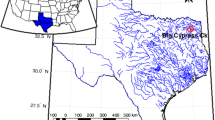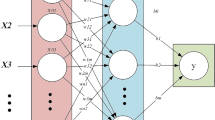Abstract
Models of river flow time series are essential in efficient management of a river basin. It helps policy makers in developing efficient water utilization strategies to maximize the utility of scarce water resource. Time series analysis has been used extensively for modeling river flow data. The use of machine learning techniques such as support-vector regression and neural network models is gaining increasing popularity. In this paper we compare the performance of these techniques by applying it to a long-term time-series data of the inflows into the Krishnaraja Sagar reservoir (KRS) from three tributaries of the river Cauvery. In this study flow data over a period of 30 years from three different observation points established in upper Cauvery river sub-basin is analyzed to estimate their contribution to KRS. Specifically, ANN model uses a multi-layer feed forward network trained with a back-propagation algorithm and support vector regression with epsilon intensive–loss function is used. Auto-regressive moving average models are also applied to the same data. The performance of different techniques is compared using performance metrics such as root mean squared error (RMSE), correlation, normalized root mean squared error (NRMSE) and Nash-Sutcliffe Efficiency (NSE).






Similar content being viewed by others
Notes
A technical organization under the Ministry of Water Resources, Government of India http://www.cwc.nic.in/
References
Box GEP, Cox DR (1964) An Analysis of Transformations. J R Stat Soc Ser B Methodol 26(2):211–252
Box GEP, Jenkins GM, MacGregor JF (1974) Some Recent Advances in Forecasting and Control. J R Stat Soc: Ser C: Appl Stat 23(2):158–179
Box GEP, Jenkins GM (1976) Time Series Analysis. Forecasting and Control. Holden-Day, San Francisco, California, USA
Box GEP, Pierce DA (1970) Distribution of Residual Autocorrelations in Autoregressive-Integrated Moving Average Time Series Models. J Am Stat Assoc 65(332):1509–1526
Bartolini P, Salas JD, Obeysekera JTB (1988) Multivariate Periodic ARMA (1,1) Processes. Water Resour Res 24:1237–1246
Brockwell PJ, Davis RA (1991) Time Series: theory and Methods, 2nd edn. Springer, New York
Campolo M, Soldati A, Andreussi P (2003) Artificial Neural Network Approach to Flood Forecasting in the River Arno. Hydrol Sci J 48(3):381–398
Carlson RF, MacCormick AJA, Watts DG (1970) Application of Linear Random Models to Four Annual Streamflow Series. Water Resour Res 6:1070–1078
Coulibaly P, Baldwin CK (2005) Nonstationary Hydrological Time Series Forecasting Using Nonlinear Dynamic Methods. J Hydrol 307(1–4):164–174
Hagan MT, Howard BD, Mark HB (1996) Neural Network Design. Pws Pub, Boston
Haykin S (2006) Neural Networks: A Comprehensive Foundation. Pearson
Hipel KW, McLeod AI, Lennox WC (1977a) Advances in Box-Jenkins modeling: 1. Model construction. Water Resour Res 13:567–575
Hipel KW, McLeod AI, Lennox WC (1977b) Advances in Box-Jenkins modeling: 2. Applications. Water Resour Res 13:577–586
Huang M, Tian Y (2011) Hydrologic Data Exploration and River Flow Forecasting Using Self-organizing Map and Support Vector Regression. International Workshop on Advanced Computational Intelligence
Hu TS, Lam KC, Ng ST (2001) River Flow Time Series Prediction with a Range-Dependent Neural Network. Hydrol Sci J 46(5):729–745
Lin JY, Cheng CT, Chau KW (2006) Using Support Vector Machines For Long-Term Discharge Prediction. Hydrol Sci–J–Des Sci Hydrol 51(4):599–612
Kothyari UC, Singh VP (1999) A Multiple-Input Single-Output Model for Flow Forecasting, Journal of Hydrology; 220. Issues 1–2:12–26
Lawrance AJ, Kottegoda N (1977) Stochastic Modelling of Riverflow Time Series. J R Stat SocSer A (Gen) 140(1):1–47
Modarres R Eslamian SS (2006) Streamflow Time Series Modeling of Zayandehrud River. Iranian Journal of Science & Technology, Transaction B, Engineering; 30, No. B4.
Majumdar PP, Nagesh Kumar D (1990) Stochastic Models of Streamflow-Some Case Studies. Hydrol Sci J 35(4):395–410
Matos JP, Cohen Liechti T, Juízo D, Portela MM, Schleiss AJ (2013) Can Satellite Based Pattern-Oriented Memory Improve the Interpolation of Sparse Historical Rainfall Records? J Hydrol 492(7):102–116
Nagesh Kumar D, Srinivasa Raju K, Sathish T (2004) River Flow Forecasting Using Recurrent Neural Networks. Water Resour Manag 18(2):143–161
Nash JE, Sutcliffe JV (1970) River Flow Forecasting Through Conceptual Models Part I –A Discussion of Principles. J Hydrol 10(3):282–290
Phatarfod R (1989) Riverflow and Reservoir Storage Models. Math Comput Model 12(9):1057–1077
Pulido-Calvo I, Portela MM (2007) Application of Neural Approaches to one-Step Daily Flow Forecasting in Portuguese Watersheds. J Hydrol 332:1–15
Rao AR, Kashyap RL, Mao LT (1982) Optimal Choice of Type and Order of River Flow Time Series Models. Water Resour Res 18:1097–1109
Salas JD, Obeysekera JTB (1982) ARMA Model Identification of Hydrologic Time Series. Water Resour Res 18:1011–1021
Samsudin R, Saad P, Shabri A (2011) River Flow Time Series Using Least Squares Support Vector Machines. Hydrol Earth Syst Sci 15:1835–1852
Shijin L, Lingling J, Yuelong Z, Ping B (2012) A hybrid Forecasting Model of Discharges based on Support Vector Machine. Procedia Eng 28:136–141
Smola AJ, Scholkopf B (2004) A Tutorial on Support Vector Regression. Stat Comput 14:199–222
Wu JS, Han J, Annambhotla S, Bryant S (2005) Artificial Neural Networks for Forecasting Watershed Runoff and Stream Flows. J Hydrol Eng 10(3):216–222
Wang WC, Chau KW, Cheng CT, Qiu L (2009) A Comparison of Performance of Several Artificial Intelligence Methods for Forecasting Monthly Discharge Time Series. J Hydrol 374(3–4):294–306
Yu PS, Chen ST, Chang IF (2006) Support Vector Regression for Real-Time Flood Stage Forecasting. J Hydrol 328:704–716
Vapnik VN (1998) Statistical learning theory. Wiley. 1 edition.
Valipour M, Banihabib ME, Behbahani SMR (2012) Parameters Estimate of Autoregressive Moving Average and Autoregressive Integrated Moving Average Models and Compare Their Ability for Inflow Forecasting. J Math Stat 8:330–338
Zealand CM, Burn DH, Simonovic SP (1999) Short Term Streamflow Forecasting Using Artificial Neural Networks. J Hydrol 214:32–48
Author information
Authors and Affiliations
Corresponding author
Rights and permissions
About this article
Cite this article
Patel, S.S., Ramachandran, P. A Comparison of Machine Learning Techniques for Modeling River Flow Time Series: The Case of Upper Cauvery River Basin. Water Resour Manage 29, 589–602 (2015). https://doi.org/10.1007/s11269-014-0705-0
Received:
Accepted:
Published:
Issue Date:
DOI: https://doi.org/10.1007/s11269-014-0705-0




